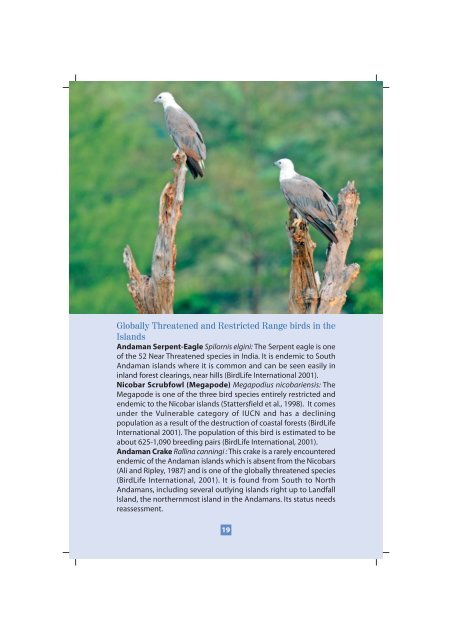Andaman booklet aw.FH10 - Zoological Survey of India
Andaman booklet aw.FH10 - Zoological Survey of India Andaman booklet aw.FH10 - Zoological Survey of India
Dugong Dugong dugon: The Dugong dugon (Muller) or sea cow is the only existing species in the family Dugongidae under the Order Sirenia and the only herbivorous mammal in the marine ecosystem. Dugongs Dugong dugon, which are listed as Vulnerable in the IUCN Red List of Threatened Species (IUCN 2000), occur in limited and scattered small populations in areas where there are good seagrass beds. Long-tailed Macaque Macaca fascicularis umbrosa: It inhabits Great Nicobar island, Katchal island and Little Nicobar Island in Southern groups of Andaman and Nicobar Islands. Their preferred habitats are mangroves, coastal forests and riverine, they are also found in inland forest at altitude of up to 600 m above sea level. The Longtailed Macaque is an endangered primate in India and it has been listed in Schedule-I of the Wildlife Protection Act 1972. It occurs only in the Nicobar Islands of India.Their conservation status as documented by the IUCN Red List is listed as Near Threatened, having been amended in 2004 from the taxon's previous status as Data Deficient following some basic surveys. 18
Globally Threatened and Restricted Range birds in the Islands Andaman Serpent-Eagle Spilornis elgini: The Serpent eagle is one of the 52 Near Threatened species in India. It is endemic to South Andaman islands where it is common and can be seen easily in inland forest clearings, near hills (BirdLife International 2001). Nicobar Scrubfowl (Megapode) Megapodius nicobariensis: The Megapode is one of the three bird species entirely restricted and endemic to the Nicobar islands (Stattersfield et al., 1998). It comes under the Vulnerable category of IUCN and has a declining population as a result of the destruction of coastal forests (BirdLife International 2001). The population of this bird is estimated to be about 625-1,090 breeding pairs (BirdLife International, 2001). Andaman Crake Rallina canningi : This crake is a rarely encountered endemic of the Andaman islands which is absent from the Nicobars (Ali and Ripley, 1987) and is one of the globally threatened species (BirdLife International, 2001). It is found from South to North Andamans, including several outlying islands right up to Landfall Island, the northernmost island in the Andamans. Its status needs reassessment. 19
- Page 1: Fauna of Protected Areas of Andaman
- Page 4 and 5: CITATION Sivaperuman, C. and Raghun
- Page 6 and 7: Saddle Peak in North Andaman and 64
- Page 8 and 9: identifiable groups. Of these, only
- Page 10 and 11: million) km2 (Saldanha, 1989). The
- Page 12 and 13: Dermochelys coriacea, Reticulated P
- Page 14 and 15: 36. Jungle Island Wildlife Sanctuar
- Page 16 and 17: Fauna of Andaman and Nicobar Island
- Page 18 and 19: diversity of reef fish. These brigh
- Page 20 and 21: Some important animals in the prote
- Page 24 and 25: Andaman Wood Pigeon Columba palumbo
- Page 26 and 27: Nicobar Scops-Owl Otus alius: The N
- Page 28 and 29: Studies conducted by Zoological Sur
- Page 30: Biodiversity Conservation Prioritie
Globally Threatened and Restricted Range birds in the<br />
Islands<br />
<strong>Andaman</strong> Serpent-Eagle Spilornis elgini: The Serpent eagle is one<br />
<strong>of</strong> the 52 Near Threatened species in <strong>India</strong>. It is endemic to South<br />
<strong>Andaman</strong> islands where it is common and can be seen easily in<br />
inland forest clearings, near hills (BirdLife International 2001).<br />
Nicobar Scrubfowl (Megapode) Megapodius nicobariensis: The<br />
Megapode is one <strong>of</strong> the three bird species entirely restricted and<br />
endemic to the Nicobar islands (Stattersfield et al., 1998). It comes<br />
under the Vulnerable category <strong>of</strong> IUCN and has a declining<br />
population as a result <strong>of</strong> the destruction <strong>of</strong> coastal forests (BirdLife<br />
International 2001). The population <strong>of</strong> this bird is estimated to be<br />
about 625-1,090 breeding pairs (BirdLife International, 2001).<br />
<strong>Andaman</strong> Crake Rallina canningi : This crake is a rarely encountered<br />
endemic <strong>of</strong> the <strong>Andaman</strong> islands which is absent from the Nicobars<br />
(Ali and Ripley, 1987) and is one <strong>of</strong> the globally threatened species<br />
(BirdLife International, 2001). It is found from South to North<br />
<strong>Andaman</strong>s, including several outlying islands right up to Landfall<br />
Island, the northernmost island in the <strong>Andaman</strong>s. Its status needs<br />
reassessment.<br />
19



